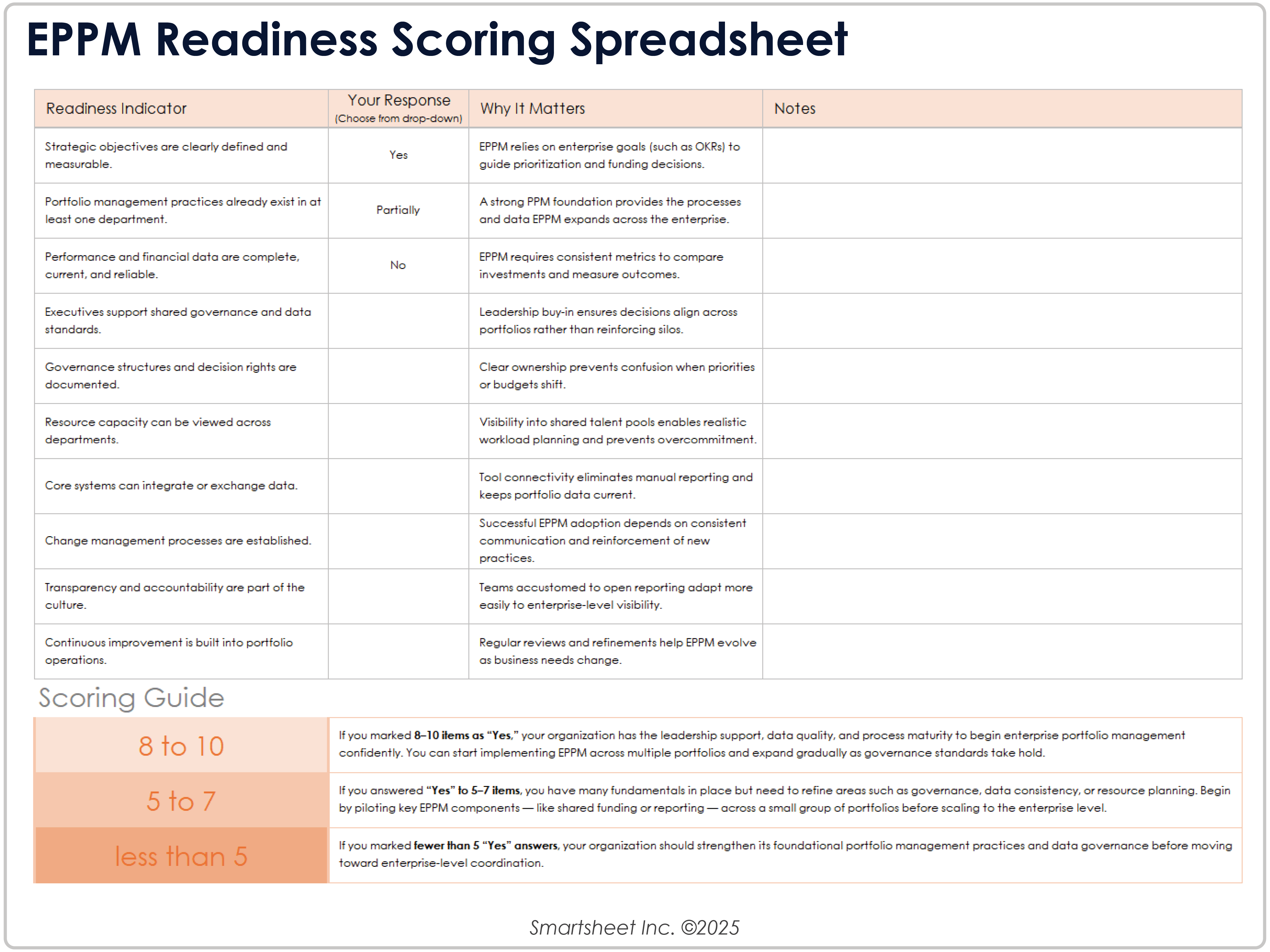What Is Enterprise Project Portfolio Management (EPPM)?
Enterprise project portfolio management (EPPM) is the coordinated management of multiple portfolios across an organization to ensure consistent governance, prioritization, and reporting. It builds on established portfolio management practices by linking them through shared standards, enterprise visibility, and strategic funding decisions.
Summary Overview
|
EPPM integrates and extends project portfolio management, creating a common framework that helps leaders compare project investments, balance capacity, and allocate resources across the organization.
Many organizations begin with project portfolio management in one or two departments — often IT or product development — to bring order to competing initiatives. As other functions adopt similar practices, leaders realize they can’t easily compare portfolios, coordinate funding, or balance shared resources. Enterprise project portfolio management (EPPM) connects those efforts through unified governance and reporting, giving executives a single view of priorities, budgets, and capacity across the organization.
Once that unified governance is in place, EPPM links strategy to execution by tying every portfolio decision to measurable business goals. Many organizations use objectives and key results (OKRs) to express those goals, while others rely on scorecards or strategic themes. EPPM connects these objectives to funding, resources, and performance, ensuring all portfolios contribute to enterprise priorities.
EPPM adds value through:
- Consistent Standards: EPPM establishes one intake and approval model for every portfolio, eliminating redundant scoring systems.
- Comparable Data: Leaders can evaluate portfolios side by side and identify overlaps using EPPM’s shared metrics and dashboards.
- Enterprise Trade-Offs: EPPM enables leaders to rebalance funding and capacity when priorities shift across divisions.
How Is Enterprise PPM Different From Traditional PPM?
Enterprise project portfolio management extends traditional PPM to the whole organization. While PPM optimizes how portfolios deliver value, EPPM ensures that all portfolios do so under the same strategy, funding model, and governance framework.
Project portfolio management (PPM) became a standard practice in the early 2000s, helping organizations select and manage projects in specific departments, such as research or IT. As portfolio management matured across departments, many enterprises realized they lacked a unified view of performance and funding. Enterprise project portfolio management (EPPM) evolved to close that gap.
PPM remains the foundation for sound portfolio management at any level. EPPM builds on it, providing the structure to coordinate those practices across departments and ensuring that resources, priorities, and reporting standards align with the enterprise strategy.
“The real value of enterprise project portfolio management lies in its ability to connect every project to the organization’s bigger goals,” says Yad Senapathy, Founder and CEO of the Project Management Training Institute (4PMTI). “It brings a single view of all work, resources, and costs across departments, which traditional PPM rarely achieves. This unified system helps leaders see where money and time are being spent and how projects contribute to strategic outcomes.”
| Dimension | Project Portfolio Management (PPM) | Enterprise Project Portfolio Management (EPPM) |
|---|---|---|
| Scope | Applies portfolio management within a defined area or line of business | Connects multiple portfolios across the organization under common standards and oversight |
| Focus | Aligns projects to strategic goals within a single portfolio | Aligns all portfolios to enterprise objectives and balances competing investments |
| Governance | Managed through a PMO or portfolio steering committee | Directed by an enterprise PMO (EPMO) that enforces standards and oversees funding |
| Resource Management | Optimizes resources within a portfolio or department | Manages enterprise-wide capacity to lessen conflicts and balance shared services |
| Visibility | Offers dashboards for portfolio performance | Provides a single view of investments, capacity, and risk across all portfolios |
What Are the Benefits of EPPM?
Enterprise project portfolio management (EPPM) provides large organizations with a unified framework for allocating time, budget, and talent. It improves visibility across the organization to allow better analysis of capacity and risk, and it enables faster decision cycles. It also helps organizations look at the long-term effects and benefits of their investments.
With strong implementation, EPPM benefits include the following:
- Unified Strategy Execution: Using EPPM, every portfolio and investment is aligned with enterprise objectives.
- Enterprise Visibility: The right platform provides a single, organization-wide view of spending, capacity, progress, and risk.
- Investment Analysis: Leaders can compare initiatives using the same criteria and allocate resources to the highest-value work.
- Cross-Portfolio Resource Balance: Demand and capacity are planned at the enterprise level with EPPM, ensuring that resourcing is effective and no one is overbooked.
- Governance and Compliance: A company can maintain controls and be better prepared for audits with the common intake, approvals, and standards afforded by EPPM.
- Faster Decision Cycles: When priorities change, consistent data and dashboards let EPPM leaders rebalance quickly and confidently.
- Management of Risk and Dependencies: Interdependencies surface early with EPPM, reducing enterprise-level exposure and schedule surprises.
- Benefits Realization Tracking: EPPM allows outcomes to be measured beyond delivery dates to show whether investments produced the expected value in the long run.
- Cultural Alignment: Standardized decision-making rules encourage cross-team collaboration.
Common EPPM Challenges and Tips to Overcome Them
Enterprise project portfolio management (EPPM) takes dedication to implement. The biggest hurdles stem from executive alignment, standardized data, team resistance to change, disconnected systems, and bureaucracy.
Here’s a look at the obstacles, including tips to handle them:
- Getting Consensus on a Standardized Approach: EPPM requires agreement on how you will plan, track, and report work across business units. Achieving that consensus can be especially challenging in matrixed organizations.
“The biggest challenge is that a successful EPPM approach requires consensus throughout the organization on how work will be managed — from individual task management up to portfolio-level reporting,” says Lulu Richter, Senior Technical Project Manager at Smartsheet. “In enterprise organizations, large workforces and often complex reporting structures make finding a single, consistent management approach for all use cases exceptionally challenging.”
Getting consensus typically requires well-defined objectives, input from all departments, and a visible commitment to a unified EPPM approach.
- Ensuring the EPMO Maintains Clear Authority: The enterprise project management office requires clear authority from executive leadership to enforce portfolio-level decisions and avoid departmental siloes.
“The hardest part of implementing or supporting EPPM is not the software or the processes; it is consistently enforcing portfolio-level governance,” says Mark Friend, Director at Classroom365 and former Global VPN Project Manager at the British Council.
“Moving from departmental PPM, every unit, department, or silo believes its own projects are the most important concern,” he says. “The challenge we had here was easily overcome by giving the EPMO direct, clear authority from the very top of executive leadership.”
- Managing Organizational Change: Change management continues to test large organizations. Frequent reprioritization, communication shortfalls, and insufficient visibility can cause problems even for mature portfolios.
According to the 2025 Project and Portfolio Management Priorities Report by Smartsheet, 92 percent of professionals said adapting to organizational change is difficult, and 61 percent of employees at large enterprises agreed that their company did a poor job of adapting to change. To overcome that, most complex organizations need strong EPPM with a change management plan.
“The hardest part of implementing EPPM is overcoming resistance to change,” Senapathy says. “Many teams are protective of their own data and hesitant to lose control.” However, he says, “building understanding starts with transparency. When people see how shared visibility benefits everyone, trust starts to grow. Showing leaders how fragmented systems waste effort often opens their eyes to the potential of EPPM. Once that happens, adoption becomes easier because they support the shift.”
- Inconsistent Data Across Portfolios: Portfolios often track work differently — by cost centers, time periods, or maturity level — making consolidation difficult. Two-thirds of the PPM professionals surveyed in the Project and Portfolio Management report said they lack data visibility to make smart pivots; disconnected tools and systems create siloed reports and undermine the single source of truth essential for EPPM. Standardized data can help ensure enterprise reporting accuracy and efficient resource management. This might include investing early in integration architecture and automation.
- Resistance to Centralized Governance: Shifting control from local portfolio leaders to an enterprise PMO can feel bureaucratic. Managers may perceive new approval gates as red tape.
To lessen that resistance, executives should involve business unit leaders early, show how standards protect resources, and give teams input into the governance model.
- Resource Overload on Shared Teams: When multiple portfolios draw on the same departments or specialists, competing demand can lead to delays or burnout. Enterprise-level capacity planning creates steadier, more predictable workloads for teams.
- Bureaucracy: EPPM can lead to time-wasting bureaucracy and rigidity if organizations don’t methodically focus on being efficient.
Alan Zucker, a PPM consultant and coach with more than 25 years of experience, recalls an example of a company he worked with that had an enterprise portfolio management organization. The PPM team had 50-75 people, including a senior vice president, a couple of VPs, and several directors. “They implemented and customized an enterprise tool. When a member of the PPM team attended an industry conference, they watched a vendor demo and realized they balled up the tool’s implementation,” Zucker says. “The intention was to create oversight and standardization … But things just became bureaucratic.” - Loss of Momentum: Without consistent portfolio reviews and visible action arising from insights after rollout, EPPM can lose engagement and momentum. Keeping leaders accountable for data-driven decision-making ensures the proper use of EPPM.
What Is An Enterprise Project Management Office?
An enterprise project management office (EPMO) is the organization-wide governance body that oversees how portfolios, programs, and projects match strategy. The EPMO focuses on strategic alignment, reporting, governance, capacity planning and oversight, and change management across departments and portfolios.
The EPMO’s mission is to make strategy executable at scale. It ensures each project and portfolio investment supports enterprise objectives, provides consistent data for decision-making, and gives the company a single source of truth for performance.
Typical focuses of an EPMO include the following:
- Strategic Alignment: The EPMO must translate corporate goals into portfolio selection and performance measures.
- Governance and Standards: The EPMO defines how portfolios are initiated, prioritized, and reported, requiring consistency across the enterprise.
- Resource and Capacity Oversight: This involves managing cross-portfolio capacity planning and coordinating shared resources.
- Investment Planning: The EPMO also oversees how funds are disbursed, rebalanced, and tracked across portfolios.
- Performance Reporting: Enterprise reports and dashboards spotlight initiative status, pending risks, and realized benefits in one view.
- Change Enablement: The EPMO drives adoption of EPPM tools and processes for all departments and maintains engagement with communication and training.
When established effectively, the EPMO connects enterprise strategy and delivery. It provides executives with visibility into where money and effort are going, and they can see how their decisions affect organizational goals, resources, budgets, and outcomes.
How to Know if Your Organization Is EPPM-Ready
For EPPM to deliver its full value, an organization must have the structure, data discipline, and executive support to sustain it. Before launching an enterprise-wide program, it’s worth confirming that foundational conditions are in place.
EPPM readiness indicators include the following:
- Active Strategic Objectives: OKRs are defined and actively used to guide portfolio selection.
- Consistent Portfolio Practices: Departments already apply some form of PPM using shared criteria, processes, or tools to manage their own work.
- Reliable Performance Data: Project and portfolio data are complete, current, and accurate enough to support cross-portfolio comparisons.
- Executive Sponsorship: Senior leadership understands EPPM’s purpose and is committed to enforcing shared governance and data standards.
- Defined Governance Structures: The organization’s decision rights, approval gates, and review cadences are well-documented and accepted by all teams.
- Technology Infrastructure: Existing tools can integrate or exchange data, supporting a single source of truth.
- Change-Management Capability: The organization can communicate, train, and enforce new processes effectively.
- Culture of Transparency: Leaders and teams are accustomed to reporting results openly and acting on data-driven insights.
If you lack some elements, take preparatory steps first. Starting with portfolio standardization and executive governance can help build EPPM maturity before scaling to full enterprise portfolio management.
EPPM Readiness Scoring Spreadsheet
Download this free EPPM readiness scoring sheet in Excel to evaluate your organization’s current state. You can fill it out individually, in a group meeting, or as a collaborative exercise among departments. Each “yes” response counts toward your total score:
- 8–10 Yes: You’re ready to coordinate portfolios under a unified enterprise model.
- 5–7 Yes: You’re close — start by piloting shared governance and reporting across a few portfolios.
- Fewer than 5 Yes: Strengthen portfolio management fundamentals before scaling enterprise-wide.
The checklist will help you decide whether to proceed now with EPPM or methodically mature your PPM practices first.
Download the EPPM Readiness Scoring Sheet for Excel
Want a broader benchmark? You can also take this 18-question PPM maturity assessment by Smartsheet to see how your organization compares with its peers and get a free consultation.
EPPM Tools and Software
Enterprise PPM tools provide structure for planning, funding, and delivering portfolio work. The best platforms combine governance, capacity planning, integration, and AI-assisted reporting into a single, scalable environment. In addition to Smartsheet, tools such as Celoxis, Planview, Wrike, and Workfront also offer EPPM solutions.
Smartsheet recently compared the best enterprise project management software. Here’s how they stacked up:
- Smartsheet: This is best for enterprises that need scalable work management without heavy IT overhead. It supports intelligent work management, hybrid methodologies, workflow automations, and enterprise governance through configurable blueprints and dashboards. Smartsheet also offers emerging AI features that help summarize portfolio updates and surface insights directly within dashboards, extending its strength in real-time reporting.
EPPM teams use the Smartsheet Control Center for portfolio provisioning, Resource Management for capacity, and Data Shuttle or Bridge to integrate with ERP or CRM systems. Its dashboards, rollups, and access control make it a good choice for multiportfolio oversight and real-time decisions.
- Celoxis: Celoxis is best for midsize to large organizations that need strong scheduling and management of cost and resources. It includes financial modeling, scenario analysis, and role-based permissions suitable for complex governance. Celoxis also integrates with Power BI and Tableau for custom reporting.
- Monday.com: Monday.com stands out for its visual, low-code environment. It’s often adopted by enterprises that want to standardize project tracking while staying accessible to nontechnical users. It supports portfolio dashboards and cross-team work dependencies, and it integrates with Slack and Microsoft Teams. Its strength lies in ease of configuration and use rather than deep resource modeling.
- Microsoft Project/Project Online: Microsoft Project is best if you’re already using Microsoft 365. It’s strong in scheduling, dependency management, and reporting, and Project Online enables multiportfolio oversight. Combined with Power BI, it delivers strong analytics for PMOs managing capital projects, IT portfolios, or multiprogram environments.
- Oracle Primavera P6: Primavera P6 is the standard for engineering, construction, and capital-intensive industries. It excels at detailed scheduling, cost tracking, and resource planning for large, multiyear projects. EPPM leaders in sectors such as utilities, infrastructure, and oil and gas rely on Primavera for compliance, earned-value analysis, and contract-based project governance.
- Planview: Planview is designed for mature PMOs and large enterprises that need full portfolio and investment management. It has strategic planning, capacity modeling, and benefits realization tracking. Its scenario-planning and financial governance modules support continuous reprioritization of enterprise investments — a key requirement for EPPM maturity.
- Adobe Workfront: Workfront is popular with creative, marketing, and operations teams in large enterprises. It provides a structured intake, automated approvals, and audit-ready workflows. Its Adobe Experience Cloud integration makes it a good choice for managing marketing portfolios or customer experience initiatives.
- Wrike: This is favored by digital and marketing teams that need enterprise-grade reporting, resource monitoring, and strong collaboration. Wrike’s dashboards and automation features make it a good fit for distributed enterprises.
What Smartsheet Uniquely Offers for EPPM
Many enterprise PM platforms force trade-offs between rigid governance and team flexibility. Smartsheet offers more balance by delivering centralized oversight without limiting how teams organize and execute their work.
Smartsheet reflects the core EPPM principles. Strategy-to-investment alignment, flexible funding, cross-portfolio visibility, shared resource management, and enterprise dashboards all operate in one connected platform.
Here’s why Smartsheet stands out:
- Balance: Few platforms balance governance and flexibility well. Many excel at project or departmental PPM but struggle to scale those practices enterprise-wide. Smartsheet does both. It supports the delivery team’s environment and the executive or EPMO layer’s need for consistency, transparency, and scale.
- Growth: Smartsheet offers a clear path to maturity. Organizations can evolve from local portfolio control to enterprise governance without abandoning the tools and habits that teams already know.
- AI Capabilities: Smartsheet is weaving AI throughout its platform. The new Smartsheet Knowledge Graph, built on AWS Neptune, models and links relationships between people, projects, workspaces, and content. It enables intelligent work management, smart task recommendations, personalized workspace insights, and governed automations in the pipeline for enterprise-scale.
Smartsheet centralizes insight without creating new bureaucracy. It links strategy, funding, and execution in a way that scales with the organization.
“Smartsheet is a very flexible platform for project management, and individual teams can create their own solutions and workflows while still supporting top-down project and portfolio management reporting,” says Richter.
“In particular, I use the Control Center to administer individualized project plan templates across multiple functional groups while enforcing consistency across the project summary data,” Richter adds. “This allows work to be managed according to team needs while ensuring data is aggregated consistently for leadership visibility.”
Smartsheet for Enterprise Project Portfolio Management
Manage your projects, programs, and processes at scale and empower your people to do their best work.
Smartsheet is an enterprise work management platform designed to help organizations plan, align, implement, and scale projects, programs, and portfolios in a fraction of the time. Over 85% of Fortune 500 companies trust Smartsheet to help them innovate and achieve results faster, securely, and at scale.
Revolutionize the way your team gets work done with Smartsheet. Try Smartsheet for free, today.
Enterprise Project Portfolio Management FAQs
An enterprise project management office (EPMO) builds on the PMO foundation. While a PMO manages projects and enforces delivery standards within a department, an EPMO extends that model enterprise-wide. It aligns portfolios to company strategy and governs overall funding and performance.
EPPM provides enterprise-wide visibility into capacity and demand. It consolidates data from multiple portfolios, allowing leaders to balance workloads, avoid scheduling conflicts for shared teams, and direct people and budgets toward the initiatives with the highest strategic value.
Large or multidivision enterprises gain the most from implementing EPPM, especially those running numerous concurrent portfolios across IT, operations, and product development. Regulated industries, global organizations, and companies managing capital-intensive programs benefit from EPPM’s governance, funding control, and cross-portfolio visibility.
Most organizations roll out EPPM in stages over a year or more. Early phases focus on governance and data standardization across a few portfolios, followed by broader adoption once tools, reporting, and decision frameworks stabilize across the enterprise.
Yes, EPPM complements Agile by connecting portfolio-level funding and prioritization with team-level execution. It provides guardrails and visibility without constraining delivery methods, helping executives align Agile programs with enterprise strategy and track benefits across hybrid portfolios.





